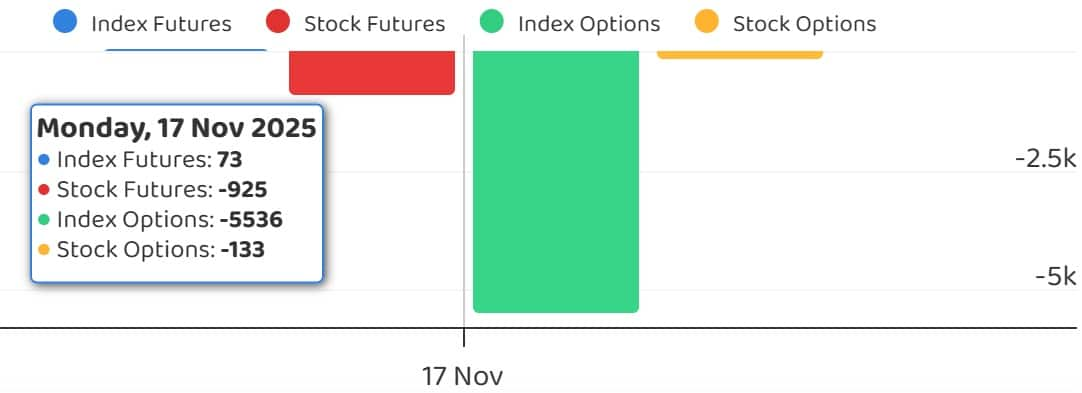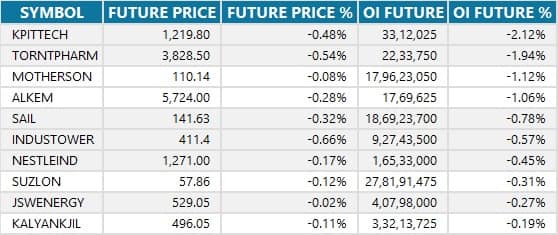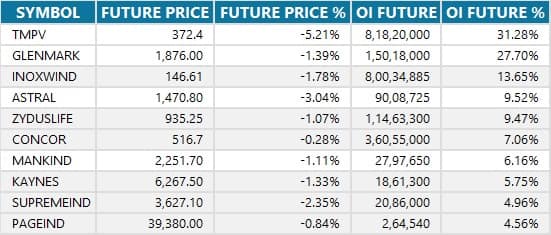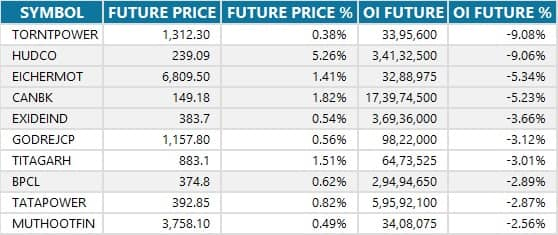



The Nifty 50 extended its upward journey for the sixth straight session, rising 0.4 percent on November 17, with technical and momentum indicators aligning with the rally. The index closed above the 26,000 level for the first time since October 29. According to experts, if the index sustains this zone, 26,100 (the October high) will be the immediate level to watch, followed by 26,300 (near the record high) in the upcoming sessions. The immediate support has also shifted higher to the 25,900–25,800 zone.

Here are 15 data points we have collated to help you spot profitable trades:
1) Key Levels For The Nifty 50 (26,013)
Resistance based on pivot points: 26,026, 26,054, and 26,099
Support based on pivot points: 25,936, 25,908, and 25,863
Special Formation: The Nifty 50 formed a bullish candle on the daily timeframe with a higher-high, higher-low structure, indicating continuation of the positive trend. The index not only traded well above all key moving averages, but the short- and medium-term moving averages also turned upward. The RSI, at 65.12, and the Stochastic RSI both maintained a bullish crossover, while the MACD is on the verge of a positive crossover, with its histogram moving closer to the zero line. All this indicates strengthening momentum and sustained bullishness.
2) Key Levels For The Bank Nifty (58,963)
Resistance based on pivot points: 59,008, 59,101, and 59,253
Support based on pivot points: 58,705, 58,612, and 58,460
Resistance based on Fibonacci retracement: 60,142, 64,208
Support based on Fibonacci retracement: 57,718, 56,923
Special Formation: The Bank Nifty tested the 59,000 mark for the first time, rising 0.76 percent after a gap-up opening, and formed a bullish candle on the daily charts, entering uncharted territory. The index closed above the upper Bollinger Band and traded well above all key moving averages. The RSI jumped to 71.41 with a positive crossover, while the MACD is on the verge of a bullish crossover, with weakness in its histogram fading considerably over the past few sessions. All this indicates continued strength and momentum in the banking space.

According to the weekly options data, the 26,000 strike holds the maximum Call open interest (with 1.42 crore contracts). This level can act as a key resistance for the Nifty in the short term. It was followed by the 26,500 strike (1.23 crore contracts) and 26,100 strike (1.17 crore contracts).
Maximum Call writing was observed at the 26,050 strike, which saw an addition of 30.44 lakh contracts, followed by the 26,250 and 26,100 strikes, which added 27.5 lakh and 26.43 lakh contracts, respectively. The maximum Call unwinding was seen at the 25,900 strike, which shed 46.5 lakh contracts, followed by the 25,800 and 26,700 strikes, which shed 38.96 lakh and 18.11 lakh contracts, respectively.

On the Put side, the maximum Put open interest was seen at the 25,900 strike (with 1.41 crore contracts), which can act as a key support level for the Nifty. It was followed by the 25,800 strike (1.11 crore contracts) and the 26,000 strike (1.08 crore contracts).
The maximum Put writing was placed at the 25,900 strike, which saw an addition of 79.25 lakh contracts, followed by the 26,000 and 25,950 strikes, which added 71.65 lakh and 64.15 lakh contracts, respectively. The maximum Put unwinding was seen at the 25,350 strike which shed 4.83 lakh contracts, followed by the 26,500 and 26,450 strikes, which shed 75,225 and 10,200 contracts, respectively.

5) Bank Nifty Call Options Data
According to the monthly options data, the maximum Call open interest was seen at the 58,500 strike, with 15.58 lakh contracts. This can act as a key level for the index in the short term. It was followed by the 60,000 strike (12.18 lakh contracts) and the 59,000 strike (12 lakh contracts).
Maximum Call writing was observed at the 58,900 strike (with the addition of 1.73 lakh contracts), followed by the 59,300 strike (99,155 contracts) and 59,100 strike (64,645 contracts). The maximum Call unwinding was seen at the 58,500 strike, which shed 3.74 lakh contracts, followed by the 58,000 and 58,600 strikes, which shed 1.85 lakh and 1.4 lakh contracts, respectively.

6) Bank Nifty Put Options Data
On the Put side, the 58,500 strike holds the maximum Put open interest (with 18.87 lakh contracts), which can act as a key support level for the index. This was followed by the 58,000 strike (16.47 lakh contracts) and the 59,000 strike (10.02 lakh contracts).
The maximum Put writing was placed at the 59,000 strike (which added 6.88 lakh contracts), followed by the 58,800 strike (3.61 lakh contracts) and the 58,900 strike (3.37 lakh contracts). There was hardly any Put unwinding seen in the 57,100-61,000 strike band.


The Nifty Put-Call ratio (PCR), which indicates the mood of the market, jumped to 1.13 on November 17, compared to 0.92 in the previous session.
The increasing PCR, or being higher than 0.7 or surpassing 1, means traders are selling more Put options than Call options, which generally indicates the firming up of a bullish sentiment in the market. If the ratio falls below 0.7 or moves towards 0.5, then it indicates selling in Calls is higher than selling in Puts, reflecting a bearish mood in the market.

9) India VIX
The India VIX, which measures expected market volatility, fell below short-term moving averages and sustained below the 12 zone, correcting for another session and signalling comfort for the bulls.

A long build-up was seen in 82 stocks. An increase in open interest (OI) and price indicates a build-up of long positions.

11) Long Unwinding (14 Stocks)
14 stocks saw a decline in open interest (OI) along with a fall in price, indicating long unwinding.

12) Short Build-up (44 Stocks)
44 stocks saw an increase in OI along with a fall in price, indicating a build-up of short positions.

13) Short-Covering (70 Stocks)
70 stocks saw short-covering, meaning a decrease in OI, along with a price increase.

Here are the stocks that saw a high share of delivery trades. A high share of delivery reflects investing (as opposed to trading) interest in a stock.

Securities banned under the F&O segment include companies where derivative contracts cross 95 percent of the market-wide position limit.
Stocks added to F&O ban: Nil
Stocks retained in F&O ban: SAIL
Stocks removed from F&O ban: Nil
Disclaimer: The views and investment tips expressed by experts on Moneycontrol are their own and not those of the website or its management. Moneycontrol advises users to check with certified experts before taking any investment decisions.
Disclaimer: Moneycontrol is a part of the Network18 group. Network18 is controlled by Independent Media Trust, of which Reliance Industries is the sole beneficiary.
Discover the latest Business News, Sensex, and Nifty updates. Obtain Personal Finance insights, tax queries, and expert opinions on Moneycontrol or download the Moneycontrol App to stay updated!
Find the best of Al News in one place, specially curated for you every weekend.
Stay on top of the latest tech trends and biggest startup news.